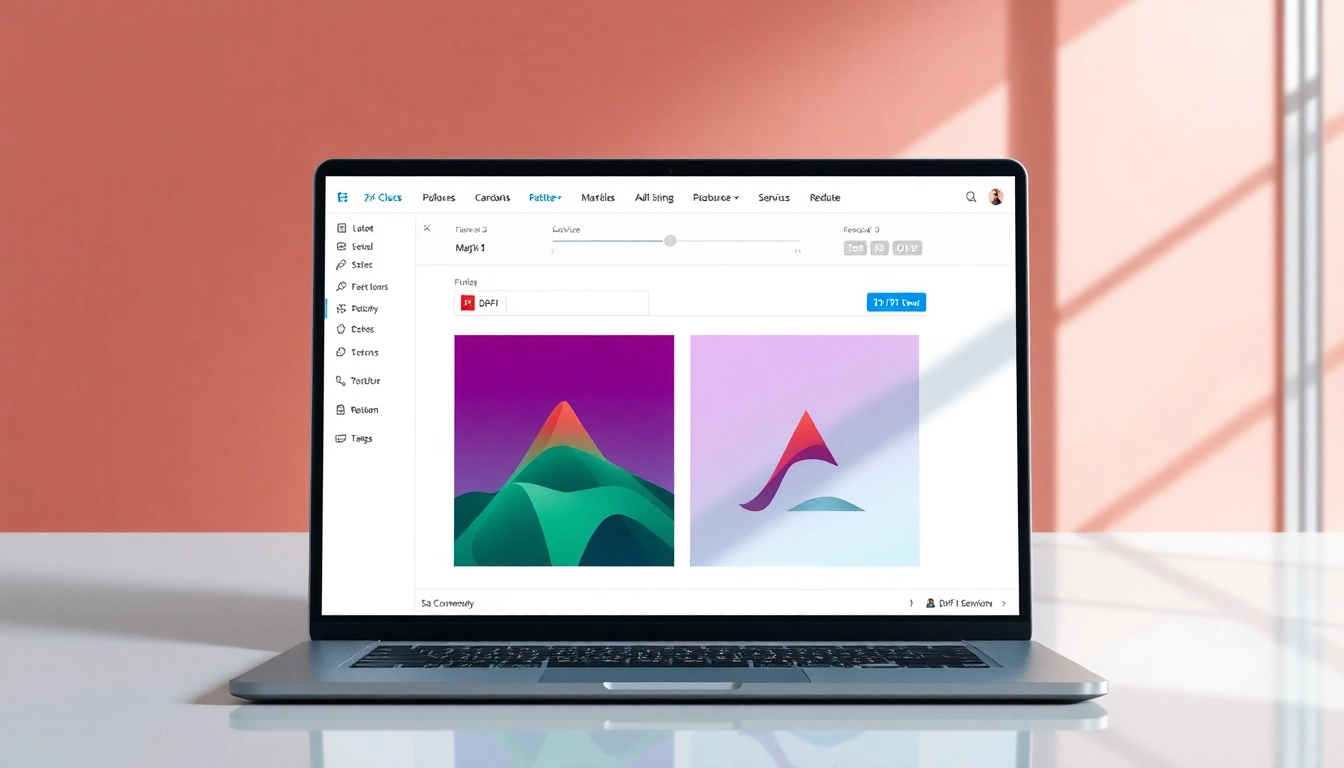Understanding the Fundamentals of Website Design
What is Website Design?
Website design refers to the process of creating and structuring websites, taking into account aesthetics, usability, and functionality. It encompasses a variety of components, from layout and color palette to typography and multimedia. Effective website design is crucial as it affects how visitors perceive a brand and their overall user experience. A well-designed website is not merely visually appealing but also meets the needs and expectations of its target audience. Moreover, a robust website design aligns with broader business goals, serving as a digital face of a company or service.
Core Principles of Effective Web Design
Effective web design hinges on several core principles that ensure a smooth and engaging user experience:
- Clarity: The design should be clear and straightforward, allowing users to navigate with ease.
- Consistency: Consistent use of colors, fonts, and layout promotes brand recognition and user comfort.
- Content Hierarchy: Information should be structured in a way that highlights the most important elements first, guiding users naturally through the site.
- Responsive Design: The website should function effectively across devices of all sizes, adjusting its layout and content accordingly.
- Accessibility: Websites should be designed to be usable by everyone, including individuals with disabilities, ensuring inclusivity.
Common Mistakes in Website Design
Even experienced designers can fall victim to common pitfalls that detract from the quality of a website. Some mistakes to avoid include:
- Overly Complex Navigation: Complicated navigation structures can frustrate users. Stick to clear, simple menus.
- Neglecting Mobile Users: Failing to optimize for mobile can alienate a significant portion of users who access websites via smartphones and tablets.
- Excessive Use of Pop-ups: While they can be effective for capturing leads, too many pop-ups can be intrusive and lead to user frustration.
- Ignoring Loading Speeds: Slow websites can lead to high bounce rates, so it’s crucial to optimize images and code for speed.
- Lack of Clear Calls to Action: Not providing clear direction on what steps users should take next can hinder conversions.
Identifying Your Target Audience
Researching User Needs and Preferences
Understanding your target audience is a vital step in the website design process. Conducting thorough research will help you gather insights about their needs, preferences, and behaviors. Effective techniques include:
- Surveys: Use online surveys to collect data from potential and existing users about their experiences and expectations.
- Analytics Tools: Leverage analytics platforms to track user behavior on your current site, revealing patterns in how visitors engage with content.
- User Interviews: Conduct interviews to gain deeper insights into user pain points and preferences.
Creating User Personas for Better Design
User personas are fictional characters that represent your target users based on the data collected during research. Creating detailed personas helps contextualize design decisions:
- Demographics: Outline age, gender, location, and other relevant details.
- Goals and Challenges: Define what users want to achieve through your website and the obstacles they face.
- Behavior Patterns: Identify how they prefer to interact with web content, such as favorite device or preferred content format.
Having specific personas allows for tailored design choices that cater to their unique needs.
Usability Testing for Effective Website Design
Usability testing is integral to creating an effective website design. By observing users as they interact with your website, you can identify areas of confusion or frustration:
- Conduct A/B Testing: Test two variations of a page to see which performs better in terms of user interaction and conversion.
- Gather Feedback: Use feedback tools to solicit user opinions on their experience and possible improvements.
- Analyze Drop-off Rates: Track at which point users leave the website and investigate potential reasons for this behavior.
Visual Elements that Enhance Website Design
Importance of Color Theory in Web Design
Color theory plays a crucial role in web design as it influences emotions and behaviors. Proper color choices can enhance the user experience by:
- Evoking Emotions: Different colors evoke different feelings—blue can signify trust, while red can create urgency.
- Improving Readability: High-contrast color combinations enhance the readability of text and navigation.
- Creating Brand Identity: Consistent use of specific colors can help embed a brand’s visual identity into users’ minds.
Typography Choices and Their Impact on Readability
Typography is an essential aspect of web design that affects both aesthetics and functionality. Selection should focus on:
- Font Selection: Choose fonts that match the tone of your content and are easy to read on screens.
- Line Spacing and Size: Ensure adequate line height and font size for comfortable reading.
- Consistent Style: Use a limited number of fonts throughout your site to maintain consistency and avoid visual clutter.
Creating Engaging Graphics for Your Website
Visual elements such as images, videos, and illustrations can significantly enhance user experience. Here’s how to create engaging graphics:
- Use High-Quality Images: Invest in professional photography or high-quality graphics that represent your brand authentically.
- Incorporate Interactive Elements: Elements like animations or infographics can help explain complex ideas and keep users engaged.
- Consistent Style: Ensure all graphics are cohesive in style and align with your overall branding.
Responsive and Mobile-Friendly Design
Why Responsiveness Matters in Website Design
As mobile web usage continues to rise, creating a responsive design is no longer optional. A responsive website provides numerous benefits:
- Improved User Experience: Users can easily navigate and interact with a website, regardless of their device.
- SEO Advantages: Search engines favor mobile-friendly websites when ranking in search results.
- Increased Audience Reach: A responsive site can attract users from various demographics who access the web via different devices.
Techniques for Optimizing Mobile User Experience
To ensure a seamless mobile experience, consider implementing the following techniques:
- Mobile-First Approach: Design the mobile version first and then adapt for larger screens.
- Touchscreen Readiness: Ensure buttons and links are sufficiently sized for tapping.
- Streamlined Content: Minimize content on mobile pages to enhance loading speed and user engagement.
Best Practices for Testing on Different Devices
Testing your website on various devices ensures a consistent user experience across platforms:
- Device Emulators: Use emulators to check how your website looks and functions across different devices.
- Browser Testing: Ensure your site operates correctly on various web browsers to avoid compatibility issues.
- User Feedback: Solicit feedback from users on multiple devices to identify pain points and areas for improvement.
Evaluating and Improving Website Design Performance
Key Performance Metrics for Website Design
To gauge the effectiveness of your website design, consider tracking the following performance metrics:
- Bounce Rate: The percentage of visitors who leave after viewing only one page; high rates may signify poor engagement.
- Average Session Duration: This indicates how long users stay on your site, which can suggest content relevancy and quality.
- Conversion Rate: Track the rate at which visitors complete desired actions, such as signing up for a newsletter or making a purchase.
Using Analytics to Inform Design Changes
Leveraging analytics tools is essential in optimizing website design. By collecting and analyzing data, you can:
- Identify Trends: Recognize patterns in user behavior to inform design decisions and enhancements.
- Segment Users: Understand different user segments’ interactions, allowing for more tailored experiences.
- Assess Content Performance: Determine which content is performing best to refine design and content strategy further.
Staying Updated with Trends in Website Design
The world of website design is always evolving. Keeping up-to-date with current trends is crucial for relevance:
- Follow Industry Blogs: Subscribe to blogs and publications that focus on web design to remain informed.
- Engage with the Community: Participate in forums and discussions with other professionals to share knowledge and insights.
- Experiment with Emerging Technologies: Stay open to trying out new tools and techniques, such as AI in design, to enhance your website’s capabilities.



